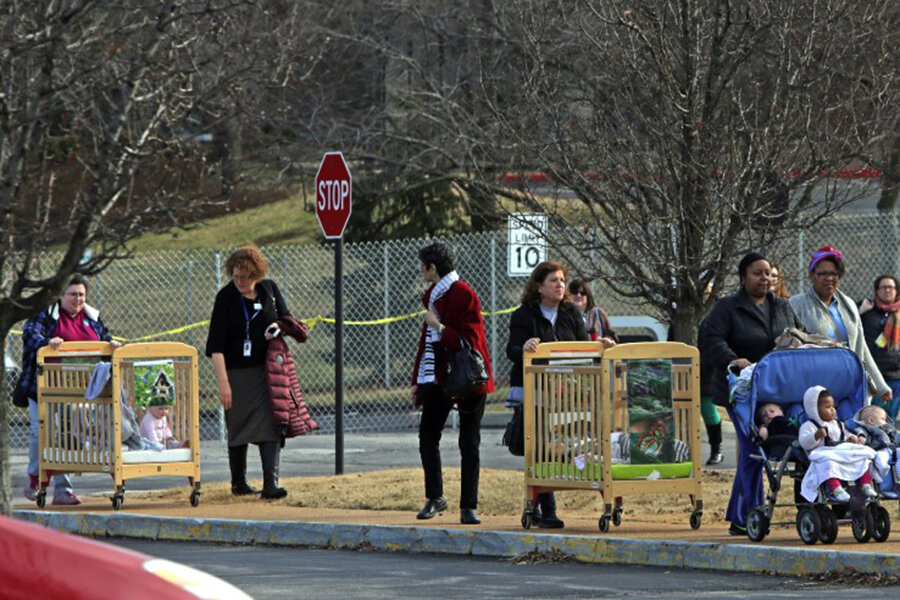Another wave of bomb threats hits US Jewish community centers
Loading...
More than two dozen Jewish community centers spread over 17 states received bomb threats on Wednesday, prompting evacuations across the United States.
All calls proved to be hoaxes and no one was injured, but an FBI investigation is underway. This spate of attacks comes less than two weeks after a separate round of threats that targeted 16 Jewish facilities in nine states. Law enforcement officials have not established a connection between the two waves, nor identified the parties responsible, but the threats come at a time when many believe the US is experiencing a rise of anti-Semitism.
A center in Miami Beach, Fla., was among those targeted. After receiving a threatening phone call at 9:54 a.m., police evacuated the area and searched with dogs, but found no bomb, they said on Twitter.
Additional threats were reported in California, New York, New Jersey, Ohio, Massachusetts, Maryland, Michigan, Minnesota, Delaware, Connecticut, Alabama, Maine, Tennessee, South Carolina, Missouri and Texas, according to the Anti-Defamation League.
“ADL is closely monitoring the situation and has been in touch with federal and local law enforcement across the country,” the group said in a statement, according to The Los Angeles Times.
No groups or individuals have claimed responsibility, and the FBI has not announced any suspects. The FBI is coordinating with the Justice Department to investigate potential civil rights violations.
"The FBI will collect all available facts and evidence, and will ensure this matter is investigated in a fair, thorough, and impartial manner," the bureau said in a statement.
While the perpetrators remain unknown, some view the hoaxes in light of the rise of the self-described “alt-right,” a movement rooted in populist white nationalism.
“My personal take is it’s a statement of where we are in this country,” Michael Feinstein, the chief executive of the Bender Jewish Community Center of Greater Washington, told The New York Times after the first round of threats earlier this month. “There’s some thought amongst some people that hate speech and hate crimes are O.K. and anti-Semitism is O.K., and I think that is reflective of sort of the political discourse that we’ve had in this country.”
Between August 2015 and July 2016, Twitter saw a spike in anti-Semitic messages, according to an October report from the Anti-Defamation League. More than 800 journalists received such tweets, as The Christian Science Monitor reported:
While blatantly racist or anti-Semitic statements are considered at worst appalling and at best taboo outside of right-wing extremist circles, sending an insulting or offensive tweet is considered brave, not shameful, among members of the alt-right and similar movements, says Nicole Hemmer, an assistant professor of presidential studies at the University of Virginia's Miller Center.
"There’s this belief that society has sort of circumscribed our language and there are certain things that you cannot say because it’s a violation against taboos," she tells The Christian Science Monitor in a phone interview. To push back against that "PC culture" by demonstrating "free speech fundamentalism," Dr. Hemmer says, "becomes an act of freedom rather than an act of offensiveness."
While some link the rise of the so-called “alt-right” with rhetoric espoused by President-elect Donald Trump during the 2016 presidential campaign, Mr. Trump has disavowed the movement. His daughter Ivanka and son-in-law Jared Kushner, Orthodox Jews, have come to his defense against claims of anti-Semitic bias.
But despite his repudiation of the group, some members of the “alt-right” may have felt emboldened after the election. In the ten days following Nov. 8, the Southern Poverty Law Center recorded 100 anti-Semitic incidents.
"These are individuals or groups that want to disrupt our way of life," Paul Goldenberg, the national director of the Secure Community Network, which advises Jewish groups, told Reuters. "We're not going to shut down institutions because of this."
This report contains material from Reuters.








